Collecting in Surinam
 |
1998 |
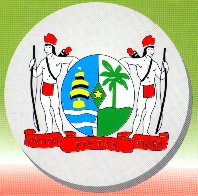 |
Text and photos by Alf Stalsberg,
unless otherwise indicated.
CLICK ON ANY IMAGE TO ENLARGE IT
We arrived in Surinam at Sanderij Airport and got stuck at Immigration. We did not have visas. I tried to argue that Norwegian citizens did not need a visa. I told them that I even sent a fax to the Surinam Consulate in Den Haag in Holland and asked them if I needed a visa to enter Surinam. The answer was no, so we went without visas and got stuck.
We even got a fine of US$40 for not having visa and another US$30 for a visa. All together US$70, and all this took time too. All the other people were already gone, and they were even closing the airport. The airport was only open Tuesday, Thursday and Sunday. The owner of the car company we had booked our car with, was waiting, and he came into the office to look for us. But at last we got our passports and could "wake up" Customs so we could get out of the airport.
We were heading to the city of Paramaribo but when we came to the suburb of Lelydorp, 15 km outside downtown Paramaribo, we found a Hotel called Hotel Lily. |
|
We got rooms and we were ready for dinner and cold beers. The local beer was Parbo, or we could buy Heineken. We needed to stay a couple of days at the hotel, because our Jeep was not ready, we had to change money, confirm our return flight and we needed another stamp in our passport. We had to get this stamp before eight days elapsed after arrival. So we decided to do these things first before we headed for the Jungle.
I had a contact person in Surinam, his name was Karel Kasanpawiro, he turned out to be a great guy, helping us with the things we needed help for. But even Ronny the guy from the car rental company was helping us a lot. He knew the word service.
I'll jump ahead a couple of days to when we got our Jeep, and we were filling the Jeep completely, we could not get more into the car. We were five persons with complete camping gear, food and our boxes to keep the fish in and more, and more ... so I could not look out the back window before we delivered the car. The car worked well, the only problem we had was several flat tyres, but we managed.
The first place we wanted to go to was Brokopondo. We drove from Paramaribo up to Paranam, then it was dirt road for the rest of the trip up to Brokopondo.
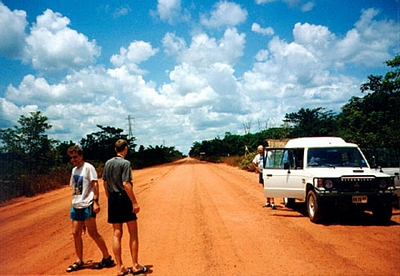 |
Dusty road, but still rather good. |
Brokopondo was a good place. There was a hut, well a roof without walls where we could hang up our hammocks and where we could cook food. Surinam River was at its best here, the water was clear, fine sand at bottom, lots of Geophagus surinamensis, Guianacara owroewefi, Rhineloricaria sp.(?)
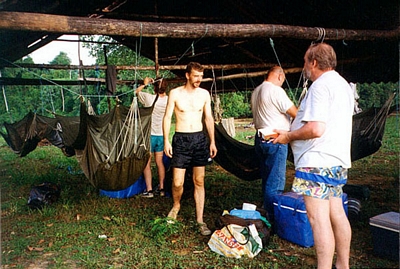
Our camp at Brokopondo. |
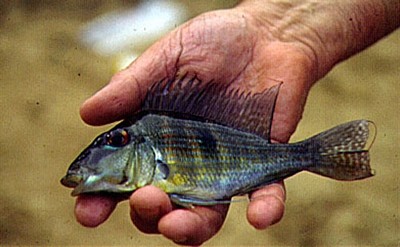
|
. |
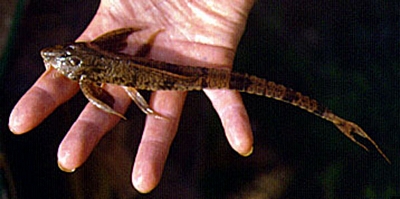
|
The water temperature was 30°C and the air temperature was 32.4°C. pH 5.5 - dH 0 - kH 0.5 - nitrite less than 0.1 - mS 20.
It was perfect, we could stay in the water all day long and collect the fish we wanted.
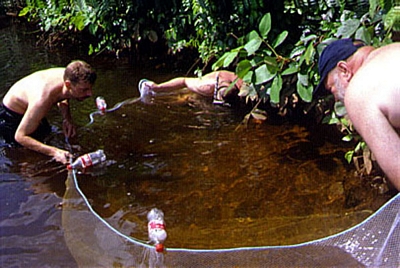
Are there any in the net? |
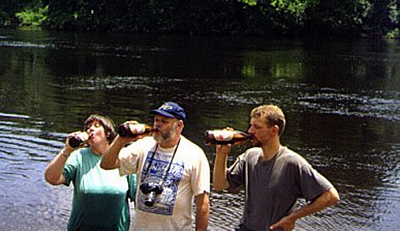
In the evening we cooked our supper and we found a place were they were selling huge beers (1 liter)! It looks good?
|
But, after a long day in the sun and the water, this was perfect too, can you imagine? I love this. The only thing I was not so happy about was the heat when we were going to bed ... sorry, hammock ... the sweat was running down your chest, no wind only the heat. But, there is always something that is not perfect. In the morning we jumped into the river, made breakfast and started changing water on the fish we had. Then we were ready to collect and study the fish in the river again. Later we decided to drive up to the Brokopondo Dam to see if we could find Geophagus brokopondo and see if there was a place to make camp for the night.
|
You can see that Lake Brokopondo is an artificial lake, you can still see trees in the water. |
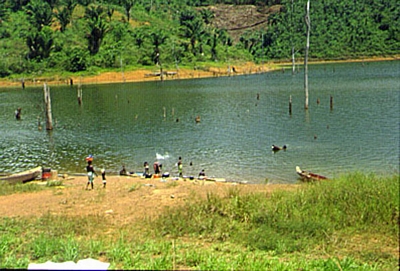
Here we are downhill from the Village Afobaka.
|
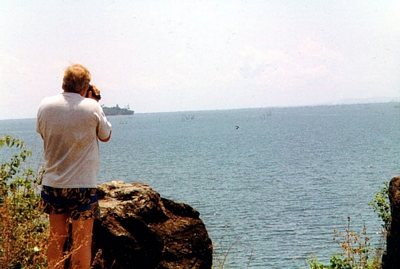 |
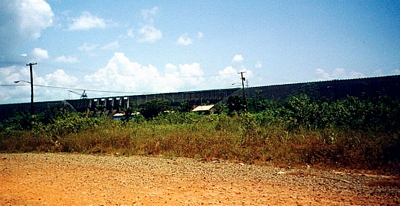
The Dam for the Brokopondo Lake.
|
We did not find a good place to stay for the night and decided to go back to Brokopondo. I was trying with my castnet before we should go back, and managed to collect two Geophagus. If these fish are Geophagus brokopondo or Geophagus surinamensis I can't tell. The two fish were put into formalin and I will probably hear from Dr Kullander when he has studied the fish, but they look pretty much alike. There are obviously some differences that are not easy for an amateur to see.
I was out diving too, and saw plenty of fish, but there was a lot of logs and rocks and that made it very difficult to use the castnet and the seine. There were a lot of hiding places for the fish there and I got a lot of tetras or sardines in the net, but not more than the two Geophagus.
We drove back to Brokopondo and lucky for us the place in the park was available. We hung up our hammocks and I started making supper while Stein Arild went to buy beer and Tom went up to the lady who was in charge of the park to pay 5000 Surinam guilden (about US$5) for the night. The next morning after breakfast and changing water on our fish, we started on the road to Pokigron (look at the map). It was out on the dusty road again, but we found a place to buy some cold ... drinks ... so we managed. We drove into the village of Pokigron, but there were no canoes there and we were told to drive a little further ahead to a place called Pokigron Atjoni, and there we found the canoes.
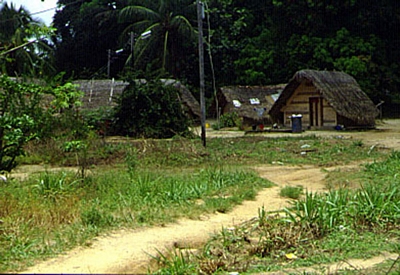 Village of Pokigron. Village of Pokigron. |
 Pokigron Atjoni. Ingemann carries the rest of our luggage down to the canoe, where you can see our fish boxes. Pokigron Atjoni. Ingemann carries the rest of our luggage down to the canoe, where you can see our fish boxes. |
It took about two hours up the river, crossing several rapids, stop at several village to deliver goods and then we came to the small camp at Djomongo falls.
We were met by Stanley Abini and his wife and they acted like we were old friends. We gave our recommendation letter from Karel Kasanpawiro to Stanley. Karel knew Stanley very well, and this letter was necessary because we could not talk Stanley's language. None of as could speak Dutch, nor "Saramaca" or "Taki-Taki" but we managed by using hands and fingers.
The water in Surinam River here at Djomongo Falls, was very hot. The water temperature was 36°C. I did not like it so hot, because you were not cooled-down by the water. I was in the water for hours, but I was still feeling rather warm.
I managed to collect a couple of "Loricaridaes", but I have no idea what the name of the fish is. |
|
The water in the river here at Djomongo Falls was rather turbid, so you could not see a fish before it was in front of your nose. But I saw Abramites sp., Anostomus anostomus, and some sardines(?). But, I did not see any Geophagus. We did collect some Rivulus sp. in a small very shallow creek, and we baptised it Djomongo Creek.
Stanley took us in his canoe to visit some small rivers with clear water, but they were so shallow we just had to walk in them and try to catch fish with our handnets. I managed to collect a small frog and took a photo of it. Tom, I think it was him, collected a "Hunter Spider" with very long legs.

|
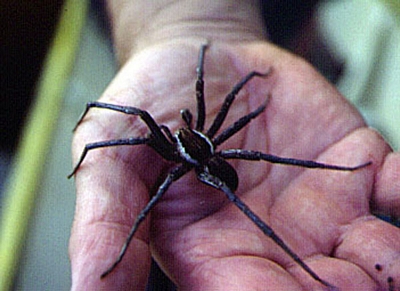
Nice, is it not? |
No one wanted to hold him so I could get a good photo of it, so I had to keep it on my hand. Stanley said it does bite, but I did not squeeze it, so no problem. I have held them before. Maybe they don't like the taste of my skin?
We looked in several small rivers, and I collected some small tetras; beyond that, we did not catch much. Well we were going back down the river next day, and we wanted to go to Brokopondo again and stay the night there.
The man with the canoe came at the right time the day after and we put our gear into his canoe and say goodbye to the Albini family. We gave Stanley one of our castnets as gift for his hospitality, and he was very glad. Before we left Surinam I gave Karel one of my nets too, so he could give it to Stanley.
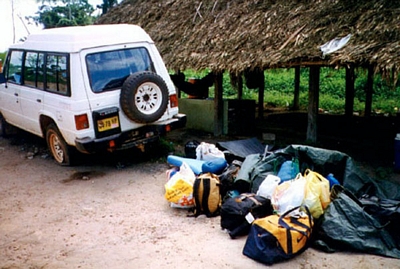 |
When we came down to Atjoni and got all of our gear up to the car, which was still there, we saw that the left back tire was flat, so I had to change the wheel before we put all our things into the car. |
When I started changing the wheel, again I think it was Stein Arild that used his head again, look at the photo in front of my face. |
|
To change the wheel was nothing when I had this in front of my face. No wonder I was smiling despite the heat. After finishing the beer, and loading our stuff in the car we hit the road to Brokopondo. There we were lucky; the hut was available, so we hung up our hammocks, changed water on our fish and started thinking about supper.
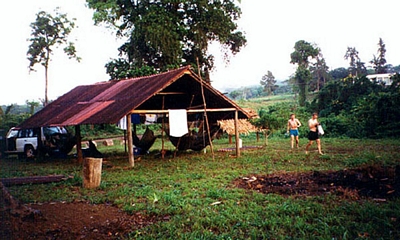 |
Next morning it was the same again, making breakfast, changing water on the fish an start packing our things into the car. |
Then we saw that there was very little air in one of the wheels again. We had to find an air-compressor, but where? So we asked the lady in charge of "the park" if she knew about an air-compressor. She thought they had one at the Commisarie. It was the office for the village community. I asked the caretaker if he had a compressor, I think he understood the word compressor, because he lifted his hand as if to say "wait a minute". He went into the back room and came back towing a small compressor.
The compressor did not have an instrument for measuring the pressure. I said 50 lbs all round. Then he took up from his pocket a big screwdriver. I wondered what he wanted with that? Then he went to one of the wheels that had good pressure, and he knocked on the wheel and listened to the sound. Then he knocked on the wheel with low pressure, and filled it up with air while he was knocking on it. And the sound was pretty much alike when he was finished. Smart! He did not ask for anything, but I gave him 500 S.G. (less than a dollar). He was smiling as we shook hands and said goodbye.
Our regular eating place, the Chinese restaurant Dja Foe. |
|
We took about 2-2.5 hours to get back to Paramaribo and our Hotel Lily and checked in before we went for lunch at our regular place, the Chinese restaurant Dja Foe.
In the evening we got a sad message, Stein Arild had to go home. He had got the message that his mother-in-law was dead.
When he got this sad message and realised he had to go home, we decided that we should collect in the local district, since we had to wait until we had placed Stein Arild on the plane to go home.
When Stein Arild left, we wanted to go to Saramaca and Coppename River, or drive as far as we could, since we were told that we could not go so far as Blanche Marie. They told us that a bridge was burnt.
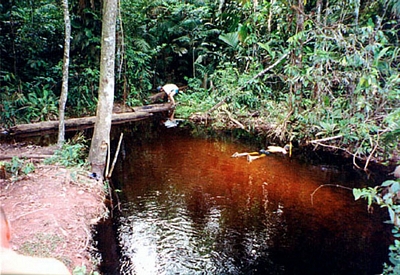
|
When you click on this photo, you can possibly imagine how we enjoyed it in the river.
|
Well we started on the dusty road and stopped at a nice biotope where we collected Apistogramma ortmanni, Nanacara anomala, Cleithracara maroni and Krobia guyanensis, Nanostomus marginatus, Copella arnoldi and other tetras.
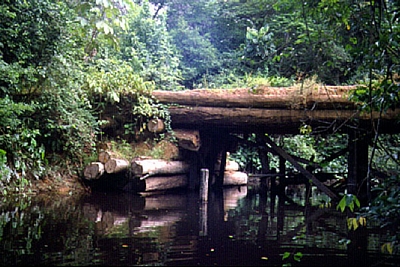
|
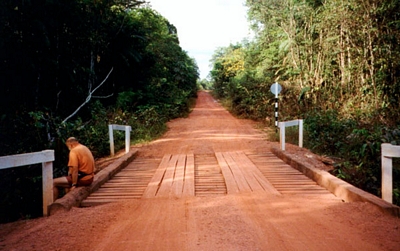
Ingemann is watching us diving in the river. |
We continue to Saramaca River which was a whitewater river, but before we crossed the bridge we saw a small black water river coming out from the forest and we decided to take a look. There was nothing to see (when we were diving) in Saramaca River. In the photos you can easily see the difference between the blackwater and the whitewater in Saramaca River. We crossed the bridge and I decided to try the castnet to see what we would get.
The fish I collected were some big tetras and a Pimelodella-type catfish. After putting the tetras in formalin we continued on the road to Coppename River. I shall not bore you with the tale about our "sight-seeing" before we at last came to Coppename River. As usual in South America, people over there think everybody knows where the roads are going, so why bother putting up signs so strangers can find the right road? So, we had a little sight-seeing before we came on the right track.
We were crossing other rivers, but since it was beginning to get late, and we wanted to get to Coppename River before dark, we decided to check some of the rivers we were passing on our way back.
At last we saw the bridge over Coppename River and that there were oil barrels placed to block the road. A man came to our car and said we could not pass the bridge.
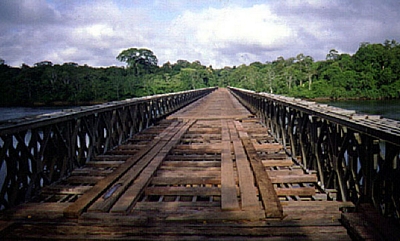
The bridge was rotten, so they were renewing planks, but they would not be finished for a month. |
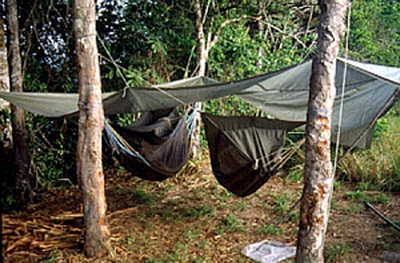
We decided to make camp there for the night and do some fishing in the morning. |
Next morning we changed water on our fish and I decided to put on my diving mask and snorkel and do some fishing. I collected Guyancara owroewefi, Krobia guyanensis and some Hypostomus sp.(?) Around lunch-time we decided to break-up our camp and start on the road back.
After some hours drive we came to a very nice biotope with blackwater and decided to use the seine net, since the bottom was of fine sand. And what a catch, in the first catch we got more than 60 Corydoras, a lot of Pimelodella sp. and plenty of small Rhineloricaria sp. This was a very good stop.
Then it started to rain very heavily, so we decided to drive on. We thought that we might be camping along the road that day, but as we were driving I was thinking of a "good bed" some cold beer and and a meal with Sweet and Sour at the Chinese restaurant. So I told the others if they bought me a couple of beers, I would drive all the way back. I think the other guys too, had the same things in mind as I had, so they agreed. After a long, hard drive on a bad road, we ended up at Hotel Lily later that evening.
Since the days had been running by very fast (they always do that when you are enjoying yourself) we did not have many days left before we would have to go home. So the last place we would visit was Maroni River or Marowinje as they called it in Surinam. Again we had good help from Karel Kasapawiro, he knew people out there we could contact and that would help us.
This time we were going to Moengo or Mongo is what they say. It's a small village/community based on the mining company SURALCO (Surinam Aluminum Company). Most of the people living there work for this company, or they own a shop etc. The guy out there had arranged rooms for us that we could hire.
To get to Moengo we had to take the ferry in Paramaribo, cross the Surinam River and drive on the road call east-west connection. We stopped in creeks, small rivers, ponds, or whatever looked interesting for us. But it was first the day. After we found places of interest, we drove on the main road to Albina, but took a right turn when we saw a sign with the name NANTI PLASI.
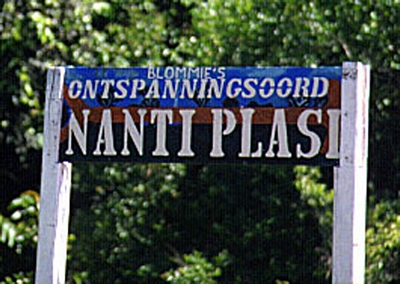 |
. |
I don't remember how far it was from Moengo, but there are not so many signs along the road, so you will easily see it on your left side. There we drove on a dirt road for about 5 km. Then we came to the river, we collected Corydoras sp. and we also collected a Crenichicla sp. that I think belongs to the saxitilis group.
The water in the river was a little turbid, but we could see for about one meter we. The mud on the bottom was easily stirred-up and then we could not see sh... But, we managed to collect some Corydoras and some Crenicichla. There were also tetras there, but we did not have any interest in collecting them. We decided the day after that it had to be the Maroni River. This was the last day that we had to collect on, because the day after that we had to go back to Paramaribo and start packing.
After breakfast we headed east to Albina and the Maroni River. We hoped that we would be able to collect Geophagus harreri, but we were not so lucky. The river was muddy and we tried to collect with the seine, but we only collected some Loricaria and some Pimelodella sp.
After fishing for a while in the heat, we decided that we deserved a couple of cold beers before we went back to Moengo. Can you imagine how good a cold beer tasted in this heat? Excellent, I can assure you that!
Well, it was time for us to think about the road back to Moengo because we were going back to Paramaribo the day after. Before we came to Moengo Ingemann said: What is this sound I'm hearing? I heard it too; "flap, flap, flap". Guess what it was? You're right, a flat tire. Well we had to change it, and we got back to Moengo a little later than we expected.
The day after on our way back to Paramaribo, we checked ponds and rivers, but some were muddy and some were blackwater. I could not see anything when I used the mask and snorkel.
When we came back to Hotel Lily, we collected fish in the evening using a light, at a place near the airport called Republiek. This was also blackwater, but it was clear and the fishes we were looking for were Mesonauta sp. and Scalare. We could collect them close to the trees where they were standing high in the water close to the roots. I collected five Scalare and 10 Mesonauta.
The Mesonauta sp. looked similar to Mesonauta insignis, so I did not bring back any live specimens. Can you guess what happened when I got back home? My friend Rainer Stawikowski told me that this fish had now been described as a new species and was called Mesonauta guyanae. It was described by Ingo Schindler, Berlin.
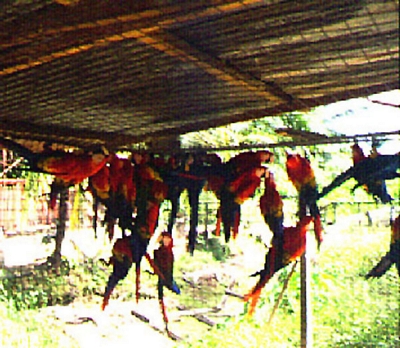
|
We did also visit a bird farm on one of the last days, and to look at these nice birds in cages makes you think.
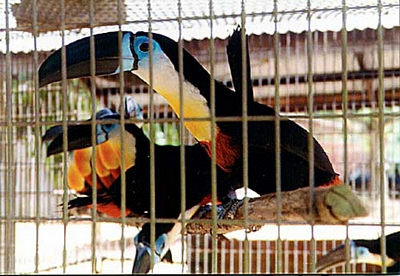
|
Back home it's nice to look at beautiful Geophagus surinamensis, Krobia, Guyanacara and dream about the the trip to Surinam. I have also started thinking about the next trip and this might be Guyana or Brazil in October, or I may wait to February/March next year and go back to a lovely country, namely Colombia.
So I hope you have had some fun reading this article, we did collect in more places than I have told you here, but this is most of the places. And you are welcome to drop me a line or two to tell me what you think about this article.